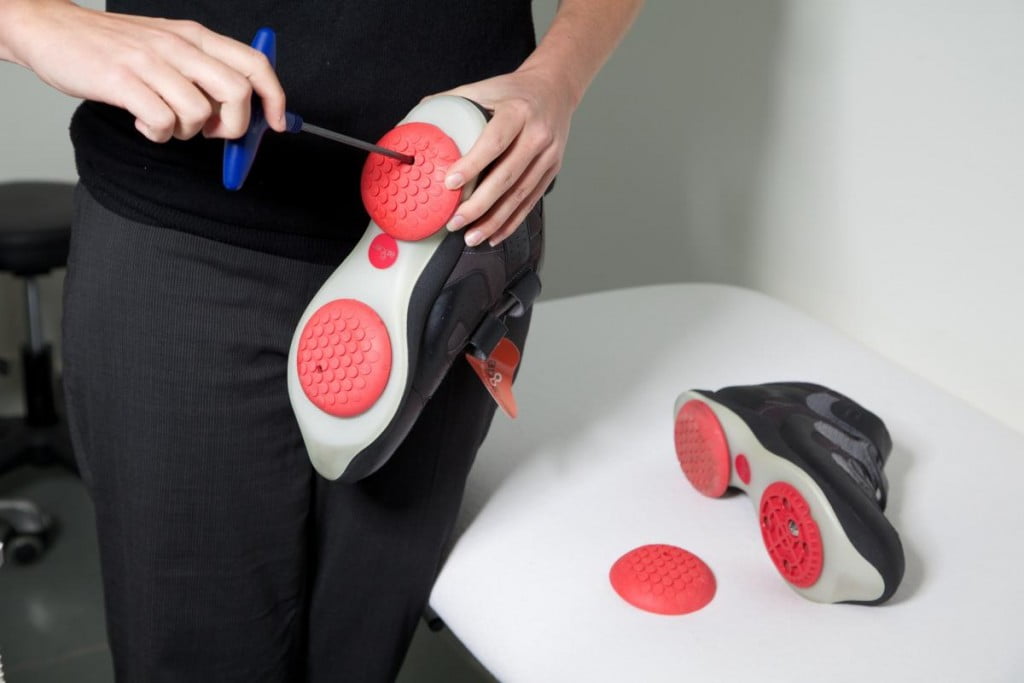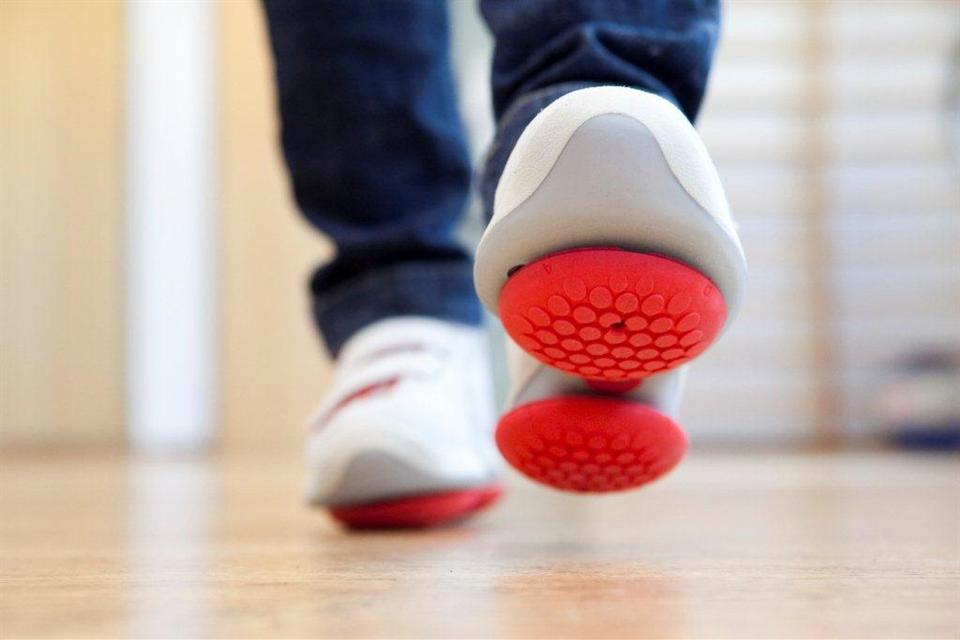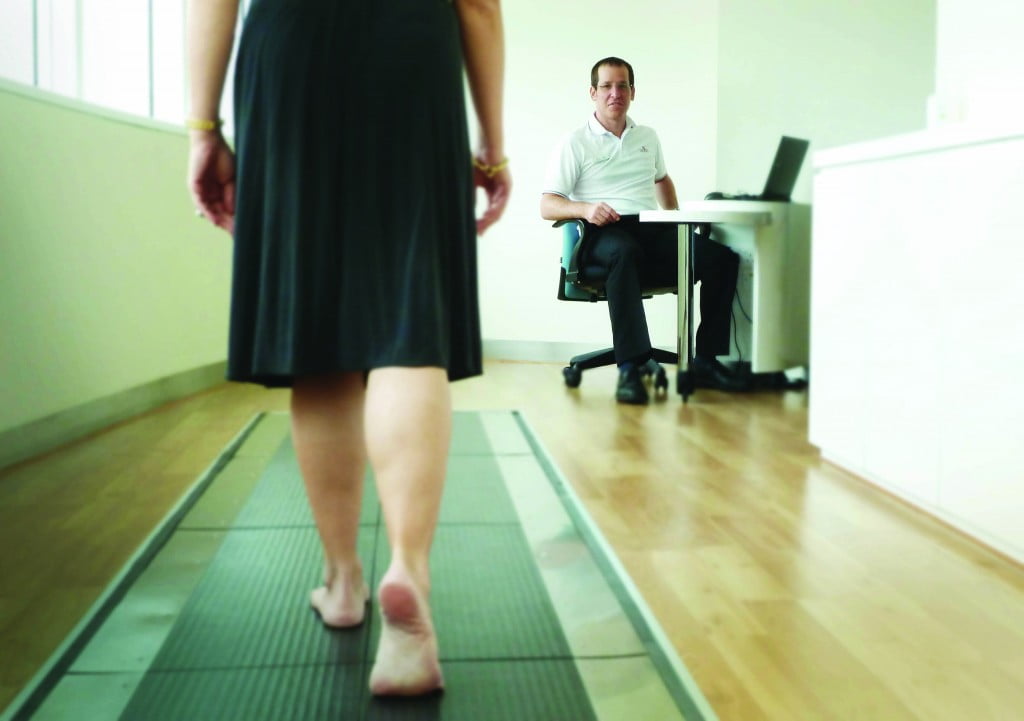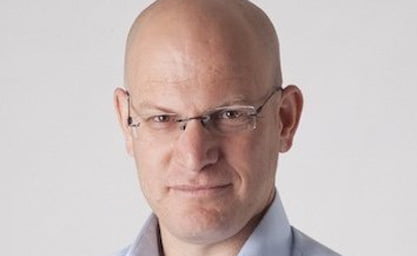Here’s a staggering statistic: According to US census data collected in 2012, over 1.7 billion people worldwide suffer from knee, back and hip pain, making it the second greatest cause of disability and the fourth greatest factor influencing the state of world health. And as the world population continues to age, particularly the baby boomer generation, the number of individuals over 65 with such conditions is expected to grow from 15 percent today to over 21 percent by 2040. With dramatic numbers like these, it’s about time that someone came up with a solution to control the prevalence of musculoskeletal conditions.
To tackle what may be the biggest downside of bipedalism, or the ability to talk on two legs, one Israeli company has thought of a novel way to ‘walk out’ knee, back and hip pain. Invented by Dr. Amit Mor and Dr. Avi Elbaz while they were still in medical school, AposTherapy takes its patients from a limping to a walking state in a matter of minutes by simply asking them to put on some funny-looking shoes.
The method of therapy is supported by notable figures in the orthopedic community, like Dr. John Hardin, Vice President of Research of the Arthritis Foundation, as well as a number of professional athletes like basketball stars Keith Lanford and Nikola Vujčić, and with good reason. As Chief Medical Officer Dr. Mor tells NoCamels, AposTherapy not only addresses one of the most common medical conditions in the world, it is heralding in a revolution in treatment that is shaped around the patient’s needs, and not the doctor’s.
‘The tsunami around the corner’
So how does one even begin to tackle a condition that affects so much of the world population, or as Mor refers to it, “the tsunami around the corner”? If you follow in the footsteps of Mor and Elbaz, it doesn’t seem too difficult a task. “The idea first came to us as medical students during the nineties. We started seeing patients from Avi’s apartment in 2005 because we didn’t have the funds for an office at the time and within five months we already had 17 employees working out of the apartment.” Those numbers have grown exponentially since, with AposTherapy’s worldwide client base now numbering 50,000 in four countries, with about 10,000 new patients joining each year and a retention rate of about 40,000 patients, according to Mor.
The reason AposTherapy has so many worldwide converts is due to the simplicity and quick results that patients see once they try out the method. “In the last two decades, many studies have shown that the muscles and nerves play a significant role in any orthopedic condition. The loss of control of the muscles and nerves, known as the loss of neuro-muscular control, occurs when the muscles tighten in the knee, back and hip areas, resulting in the pain and discomfort many feel.” Using their research and knowledge of the neuro-muscular system, and basing their method on the fact that every nerve, muscle and joint in our body works together, Mor and Elbaz realized that “distracting” the body’s attention from the area of pain was the first step in helping people comfortably live their lives.
‘Distracting’ the body to reduce pain
That’s how they came up with the idea for their patented convex shoes that, from above, look like a regular training shoe, but from below carry two convex cushions that continually force patients to correctly align their muscles, without ever having to remind them to do so. “Once joints or muscles aren’t working correctly, people start to compensate by limping or using a cane, and it’s really a vicious cycle. But because we know that neuromuscular control is central to the functioning of this system, we can train the system to tighten the muscles in the affected area, accelerating the rehabilitation process, preventing re-injury, and reducing pain,” Mor explains.
The process begins with a consultation with a licensed AposTherapy physical therapist. The therapist asks patients to walk on a sensitized runway that measures factors like gait, the length of steps, which foot you put more weight on, and other factors. Then, the patient fills out a questionnaire in which they are asked to describe the degree of their pain as well as some of their daily activities and what treatment methods they have used in the past. In a matter of minutes, a patient is “calibrated,” as they like to put it, and the therapists gets to work fitting the convex mounts on their new AposTherapy shoes. Now comes the moment of truth; the patient puts on the shoes and once again hits the runway to get a better idea of their improvement, but really there is no need for numbers because almost immediately, the patient walks freely without a limp or cane. The difference is so dramatic that it almost makes your jaw drop.
SEE ALSO: Israeli Fall-Prevention Motorized Shoe Is A Step In The Right Direction
Sign up for our free weekly newsletter
SubscribeMor shows me a video of one such patient. Maureen McKerrall suffered from acute arthritis in her knees, as well as serious back pain, and faced the possibility of undergoing surgery on both of her knees and her back. Traveling from Glasgow, Scotland to an AposTherapy practitioner in England, Maureen was out of options and very depressed by her prolonged medical state when she stepped into the office. After she was calibrated, Maureen got her first pair of AposTherapy shoes and immediately began walking with only a slight limp. Following one month of wearing AposTherapy shoes, she walked without a limp and didn’t experience the same acute pain in her knees and back. As she puts it, “People that have known me for 20 years were like, ‘I’ve never seen you walk like that.’”
Less pain and stronger muscles with every step
What makes the success of AposTherapy so fascinating is that the treatment is really as simple as putting on a pair shoes. “Once we align the patient, we send them home and we don’t say ‘go practice’ because we know that most patients don’t train or practice even if the doctor tells them so. We just say ‘be.’” The patient is asked to wear the shoes for at least one hour a day, either in the home or office, and to walk around ten percent of the time while wearing them. “As patients walk, to get a cup of coffee or to the bathroom, the system promotes stability in all phases of the step cycle,” Mor continues, explaining, “That’s why we called our company ‘AposTherapy’ because it works in all phases of the step cycle, and it is the first treatment to do so.”

Mor also knows that not only do patients make the most progress when they make their priority to practice, but that the working individual of today doesn’t have the time or patience to visit a physical therapist on a regular basis. That’s why AposTherapy decided that it will minimize the amount of physical trips a patient needs to make to a clinic down to once a month, and as they progress, once every six months, or once a year. As Mor puts it, “We know that we need to administer care in the patient’s own time and according to what is convenient in order to increase compliance and achieve the best results. This really empowers the patients to want to see change, and it’s all about democratizing medicine.”
Mor makes a keen point. In this day and age, people can do the majority of their transactions remotely, but still, in order to receive medical advice, you need to visit a doctor. This is one factor that he believes makes patients less inclined to comply with the method, which is why AposTherapy provides its patients with the shoes, asking them to do all of the work of walking around. This also trims down on factors like cost because patients no longer need to travel to and fro from their physical therapist on a weekly basis. In addition, all they need are a pair of AposTherapy shoes, while traditional physical therapy methods often ask their patients to acquire new props as their therapy progresses.
Star-studded approval
The entrepreneurial spirit of AposTherapy is not limited to its treatment methods. Starting out from Elbaz’s apartment, within the span of a few months, the shoes were fully covered by Israeli medical insurers, providing universal access to this unique method of therapy. Soon, the company spread to the United Kingdom where it is covered by the country’s largest insurer, Bupa, as well as to Singapore and the United States, where it has been approved by the Food & Drug Administration (FDA), but is not yet covered by insurance.
SEE ALSO: Israeli Company’s Futuristic Back Implant Can Repair Damaged Spines
“It’s a different era,” Mor asserts, “You cannot wait for the systems to cover things. You need to be entrepreneurial, science-driven, and just go for it.” Currently, the treatment is available in the US only in the Greater New York metro area, but Mor is confident that expansion is only a matter of time. The company already counts NBA players, NFL veterans Bart Oates and Karl Nelson and a number of notable members of the medical community, including Dr. Elton Strauss, a leading orthopedic surgeon who avoided surgery by using AposTherapy’s methods, among its notable fans. AposTherapy is also supported by a star-stunned medical advisory board with orthopedic surgery professors, sports medicine experts and the former president of the American Physical Therapy Association, Dr. Marilyn Moffat, as its medical backbone. And in 2014, AposTherapy was nominated ‘Israeli Company of the Year’ by UK Israel Business together with multinational companies like Teva and Israel Chemicals.
The buzz around AposTherapy and its international success begs the question of whether AposTherapy will pursue a public offering in the near future. Though they wouldn’t confirm their intentions, Mor and Elbaz didn’t totally reject the idea, and remain confident about the company’s next steps. “We have a powerhouse, the board of a multi-billion dollar company and those people came to us because they know that AposTherapy is a treatment that the world needs,” says Mor. “They came because they believe in the treatment and that together we can change the way that knee, hip and back conditions are treated.”
Photos: Bone and Joint Initiative USA
Related posts

Israeli Medical Technologies That Could Change The World

Harnessing Our Own Bodies For Side Effect-Free Weight Loss

Missing Protein Could Unlock Treatment For Aggressive Lung Cancer







Facebook comments